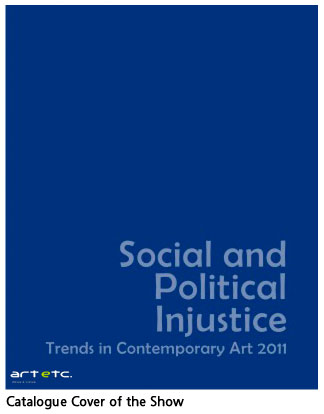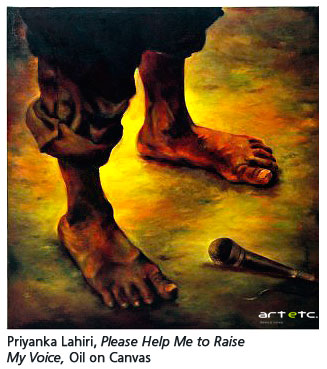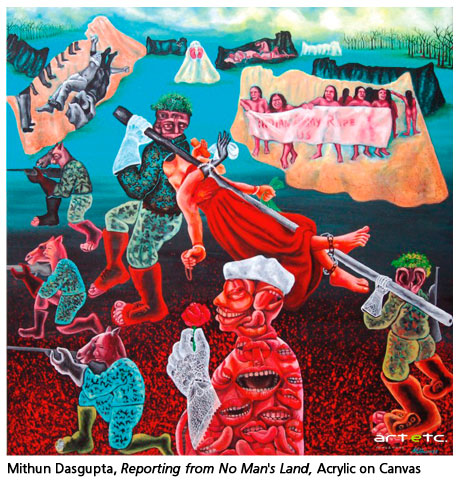- Publisher's Note
- Editorial
- What's Behind This Orange Facade!
- “First you are drawn in by something akin to beauty and then you feel the despair, the cruelty.”
- Art as an Effective Tool against Socio-Political Injustice
- Outlining the Language of Dissent
- Modern Protest Art
- Painting as Social Protest by Indian artists of 1960-s
- Awakening, Resistance and Inversion: Art for Change
- Dadaism
- Peredvizhniki
- A Protected Secret of Contemporary World Art: Japanese Protest Art of 1950s to Early 1970s
- Protest Art from the MENA Countries
- Writing as Transgression: Two Decades of Graffiti in New York Subways
- Goya: An Act of Faith
- Transgressions and Revelations: Frida Kahlo
- The Art of Resistance: The Works of Jane Alexander
- Larissa Sansour: Born to protest?!
- ‘Banksy’: Stencilised Protests
- Journey to the Heart of Islam
- Seven Indian Painters At the Peabody Essex Museum
- Art Chennai 2012 - A Curtain Raiser
- Art Dubai Launches Sixth Edition
- "Torture is Not Art, Nor is Culture" AnimaNaturalis
- The ŠKODA Prize for Indian Contemporary Art 2011
- A(f)Fair of Art: Hope and Despair
- Cross Cultural Encounters
- Style Redefined-The Mercedes-Benz Museum
- Soviet Posters: From the October Revolution to the Second World War
- Masterworks: Jewels of the Collection at the Rubin Museum of Art
- The Mysterious Antonio Stellatelli and His Collections
- Random Strokes
- A ‘Rare’fied Sense of Being Top-Heavy
- The Red-Tape Noose Around India's Art Market
- What Happened and What's Forthcoming
- Art Events Kolkata, January – February 2012
- Mumbai Art Sighting
- Art Bengaluru
- Delhi Dias
- Musings from Chennai
- Preview, February, 2012 – March, 2012
- In the News-February 2012
- Cover
ART news & views
Art as an Effective Tool against Socio-Political Injustice
Issue No: 26 Month: 3 Year: 2012
Revisited
by Haimanti Dutta Ray

From 9th September, 2011 to 30th September, 2011 Aakriti Art Gallery, Kolkata had exhibited Social and Political Injustice: Trends in Contemporary Art 2011 in which varied young artists participated and reacted to the contemporary socio-political scenario through their art.
Protest art is a broad term that refers to creative works that concern or are produced by activists and social movements and are often used as part of demonstrations or acts of civil disobedience. There are also contemporary and historical works and currents of thought that can be characterized in this way. Social movements produce such works as the signs, banners, posters and other printed materials used to convey a particular cause or message. These works tend to be ephemeral, characterized by their portability and disposability and are frequently not authored or owned by any one person. While some protest art is associated with trained and professional artists, an extensive knowledge of art is not required to take part in protest art. Protest artists frequently bypass the art world institutions and commercial gallery system in an attempt to reach a wider audience. Furthermore, protest art is not limited to one region or country, but is rather a method that is used around the world.
James Joyce had written in his colossal work, Ulysses, “Art has to reveal to us ideas, formless spiritual essences. The supreme question about a work of art is out of how deep a life does it spring.” And Somerset Maugham had stated in his Cakes and Ale: “Let us face it: beauty is a bit of a bore.” Presentation of the element of protest in art is essentially a post-modernist phenomenon. Now-a-days, of course, we speak of 'postmodernism: deconstructed'. To be vocal about the social, political and cultural atrocities being meted out everyday of our existence, in the name of populist culture, is one of our fundamental rights. It is as important as exercising our voting rights. The first step or the necessary building block for the progress of a nation must come from the masses or the general public. That voices of active protest are effective was proved recently in our state when a comparatively new political party spearheaded by a fiery and feisty woman, threw the ruling party who had solely governed the state for as long as three decades, out of power. Post modernist movements are ones that are grounded in denunciations of the commodification of art and has generated one of the most heated art markets in recent history. T.S.Eliot had realized way back in the 1920's, what was essentially a protest about the awareness of the decadence of our civilization - “The London Bridge is falling down, falling down, falling down.” Rabindranath Tagore had created a world of fantasy in and through art hence.
The spirit of protest is prevalent worldwide - Greece to Egypt, Libya to London, Russia to Wall Street, closer home the protest icon of modernday India - Anna Hazare. When there was trouble in Egypt early this year, the first thing that the Egyptian government did to suppress public dissent against authority was to shut down the Internet service in the country. That is an indicator of how digital media is invading and become an integral part of our lives - whether you are a dictator trying to stay in power, or young people trying to change the world, or whether you are trying to sell an idea, service or product. Digital media allows targeted marketing - a level of advertising where targeting the product can get so detailed like never before. When talking of digital and social media, it is important to see how global the story has become. Statistics show that there are 750 million users globally on Facebook today. Of them, around 250 million users log into the social networking site everyday. A user spends around 23 minutes a day on an average on Facebook. Around 30 million pieces of content are shared every month on the site. So advertising on these sites can have enormous marketing and connection opportunities, and that is crucial for business. Likewise, the You Tube is the world's second largest search engine after Google.
But what kind of democracy are we pretending to extol when all instances of individual opinions are either shushed or shut altogether? Kapil Sibal, the staunch crusader of Internet censorship in India, demanded that all objectionable content be removed from websites such as Google, Facebook and YouTube. The Islamic seminary has recently rejected the right of litterateur, Salman Rushdie, from coming to our country to attend the Jaipur Literary Festival. The banned Students' Islamic Movement of India (Simi) had targeted the author. This incident is being likened to M.F. Husain, who went to self exile. There are two very important flip sides to the current fad of a youth revolution. Firstly, the impact of the current youth movement is largely confined to techno-savvy, well educated urban youth. The revolution has side-stepped millions of young people who are denied a decent education or have dropped out of school before they reach the age of 10. A large number of girls never reach the school at all. There is thus a huge 'wasted resource' which does not participate in the momentum that the youth power brings to the world. Secondly, many of the urban youth continue to be victims of drug addiction. Drug habits are spreading across campuses worldwide even in the Third World countries. There is growing recognition that the world has lost many young talents due to drug addiction. Inspite of these challenges, the world has gained significantly from the current surge in youth power. India with over 500 million people below 30 years of age is the major gainer of this demographic dividend. India has today become not only the largest market in the world, but also one of the 'youngest'. Indian market is significantly tilted in favour of the young consumer and his lifestyle.
During the month of September of last year, i.e. 2011, Aakriti Art Gallery had hosted a show entitled Social and Political Injustice : Trends in Contemporary Art 2011 featuring fourteen artists. The exhibition had been conceptualized by Vikram Bachhawat, Director of Aakriti Art Gallery and the Emami Chisel Art. Contemporary art has experienced sea changes in terms of concept, medium and ultimate execution. Plurality of styles and thematic execution came to the forefront right from the beginning of the twentieth century, that has evolved what is known as 'conceptual art' in today's contemporary jargon of art. Art, as stated previously, had always been a tool of reaction, anti-establishment and a rebellion force that is hard to ignore. The thought processes and execution mechanisms have definitely altered and taken new paradigms according to the new socio-political contexts. Amidst the historical chronicles of contemporary modern art, Pablo Picasso's Guernica stands as the greatest anti war symbol of all times, and is an embodiment of peace. This artwork was conceived and created by Picasso as a reaction to the bombing of Guernica, Basque Country by German and Italian warplanes at the order of the Spanish Nationalist Forces, on April 26, 1937 during the Spanish Civil War. The role of an artist as a social commentator, pitching in and voicing his concerns against the rampant social and political injustices was the primary concern of the exhibition.



What struck the viewer most at the exhibition was the fact that all the participating artists who had been selected from a pan-Indian level, had experimented with the choice of the medium in which they had expressed their individual and artistic talent. By this gesture, all of them had registered their protests against century-old and time-tested conventions and norms. In almost all the works exhibited at the show, the average viewer was struck by the spirit of anger, protest and radical dynamism that underplayed beneath each of the artists' psyches. The fact that all of them are very young realistically sets a new edge to their visual documentations of registered protests. Artists like Buddhadev Mukherjee had chosen mixed media on acid free paper (Untitled) where man is at the centre of concentric cosmic spheres. Sagar Bhowmik's two works - But for the Grace of God 1 and 2 had stood apart both in their latent concept and executive style. In one, he had painted using water colour on acid-free paper. The have nots or the figures of destitution form central to Sagar's cosmos. Man being a mute witness to the crumbling of his aspirations, his dreams. These artists have raised a very just protest against the rampant social, economic and political injustices of our country. The only woman painter in the exhibition, Priyanka Lahiri, Help Me Raise My Voice and Unfortunate Reality ( both oil on canvases) showed what havoc juvenile and child abuse can create and permeate in our social system. In the former work, Priyanka has used the microphone as a symbol. The socially and economically down-trodden can only gape at this, and never reach its level so as to give full utterance to their traumatic existences. In the latter work, the artist has shown the loss of childhood and innocence. We live in an age where children, especially girls, are but pawns and are commodified in the society. Hence the use of the bar code. The girl is more of a product , who can be sold at a price at the market as it were, so says the artist.Mithun Dasgupta's Celebrating Independence Day and No Man's Land depicted intra- as well as inter regional strifes that are prevalent in this country through semi- beast, semi-human figures. The burning issue of Maoism seems to bother the artist's psyche which finds an apt depiction in his acrylics. In No Man's Land, the artist has made a direct reference to the atrocities meted out by the Indian Army. They had raped a woman, Manorama, in Manipur and then gunned down the protestors. Many women had paraded in the nude in protest against this. He has also tried to “internalize” his reference to Abanindranath Tagore's Bharat Mata using the “contour” technique. “I have tried to depict my own version of Bharat Mata”, says the artist. His other work at the show has references to Salvador Dali. “We are getting 'glocal' (synthesis of global and local) in that our joys, sorrows and personal feelings are being marketed. Many people find my paintings clumsy, crowdy. Different images of the same personality with layers of dimensions in them create confusion in my mind. I want to depict this confusion…. I too can become a Maoist one day.” Swapan Kumar Mullick- The Carcass of Eros (synthetic tempera, water proof on treated paper) and It's Her Wish (conti, soft pastel and ink on paper) - is concerned with the human reproductive cycle and with issues of fertility.

 Pappu Bardhan's two works in the acrylic medium showed how the feminine body and her form are but pawns to crass media culture. Debashis Dutta had shown two works at the exhibition. Memory (water colour on acid free paper) showed how this medium could be explored and executed in and through a plethora of subjects and styles. Untitled (acrylic colour on readymade objects) showed the innovativeness in content and styles of execution that contemporary artists are making their own forte. The sculpture by Akhil Chandra Das - Puzzle Box (bronze, iron and brass) - showed his signature ancient man carrying on his shoulders a rubik's cube, who is trying to solve the puzzle and put an end to the reign of terrorism. Nantu Behari Das's Cyborg ( Fibreglass) showed a human head. Girl Carrying Weeds (painted aluminium) by Tapas Biswas was striking since it suggested an aura of pristine rusticity that is but lost in the modern day machinations in the name of technology. Nothing more need to be said or written about Ketan N. Amin's sculpture Corruption (Fibreglass). It showed a human hand holding a currency note. Play With Fish And Childhood (terracotta) by Subrata Biswas again reiterated the rising phenomenon of a lost and vanishing childhood. Partha Guin had shown and experimented with diverse styles and mediums, in keeping with the rising trends in the West. Speak Out (badges installed on engraved PVC board) and 150 ml Solution (sticker, prints on paper cups) showed how protests could be registered through the choice of media and language in modern visual art..In Speak Out, he has presented physical protest as a kind of snapshot imagery. As if he were presenting it through the media, (it could be any, particularly the audio visual media) which he knows is very popular. In his second work, which is by far more interesting by virtue of its innovative technique, he has used the tea cup making rounds amidst casual banter, in trying to solve the burning issues that trouble our country. Without resorting to any kind of violence, we could (hypothetically, of course!) mitigate the severity of our situation.
Pappu Bardhan's two works in the acrylic medium showed how the feminine body and her form are but pawns to crass media culture. Debashis Dutta had shown two works at the exhibition. Memory (water colour on acid free paper) showed how this medium could be explored and executed in and through a plethora of subjects and styles. Untitled (acrylic colour on readymade objects) showed the innovativeness in content and styles of execution that contemporary artists are making their own forte. The sculpture by Akhil Chandra Das - Puzzle Box (bronze, iron and brass) - showed his signature ancient man carrying on his shoulders a rubik's cube, who is trying to solve the puzzle and put an end to the reign of terrorism. Nantu Behari Das's Cyborg ( Fibreglass) showed a human head. Girl Carrying Weeds (painted aluminium) by Tapas Biswas was striking since it suggested an aura of pristine rusticity that is but lost in the modern day machinations in the name of technology. Nothing more need to be said or written about Ketan N. Amin's sculpture Corruption (Fibreglass). It showed a human hand holding a currency note. Play With Fish And Childhood (terracotta) by Subrata Biswas again reiterated the rising phenomenon of a lost and vanishing childhood. Partha Guin had shown and experimented with diverse styles and mediums, in keeping with the rising trends in the West. Speak Out (badges installed on engraved PVC board) and 150 ml Solution (sticker, prints on paper cups) showed how protests could be registered through the choice of media and language in modern visual art..In Speak Out, he has presented physical protest as a kind of snapshot imagery. As if he were presenting it through the media, (it could be any, particularly the audio visual media) which he knows is very popular. In his second work, which is by far more interesting by virtue of its innovative technique, he has used the tea cup making rounds amidst casual banter, in trying to solve the burning issues that trouble our country. Without resorting to any kind of violence, we could (hypothetically, of course!) mitigate the severity of our situation.

We live in an age where our talent, temperament and technique are tested and stretched to the full. One has to fight with oneself and also with the world. I believe that one is one's own best critic. We have to analyze our weakness, faults and failures, which can only come through and by self belief. We live in a country where even a two-year old infant is not spared from human perversity in a metropolis like our capital city, and of course, there is the rampant violation of women's rights. The artist as a conscientious citizen does and must raise a voice of protest through his most eloquent tool, his paint brush, for everyone around the globe, understands the visual language.